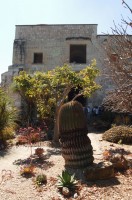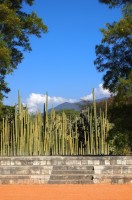Inspiration is everywhere for a garden designer on holiday, lucky enough to be in Mexico over Christmas I got to see wild Salvias growing in the hedgerows, exotic agaves seeding on the sides of the roads and Tithonias wildly seeded in the central reservations- all plants that we have to grow as half hardies or annuals in this country.
As well as these delights, one of my highlights in Mexico was getting to visit the Ethno Botanical Gardens in Oaxaca. These gardens are laid out in the orchard of the Santo Domingo Monastery in downtown Oaxaca. This botanic garden hails above the many others due to its originality of planting, the diversity of the plants all located within such a small geographical location, the lack of signage (they don’t like visual pollution) and the artistic input into the site. All of of these factors contribute to it being a fantastic public space to enjoy.

The history of the site in it self is fascinating, initially a 16th Century Monastery, which was taken over as a military base for 120 years. The military were kicked out by the president thanks to the lobbying of Pro-Oax, an advocacy group urging the promotion and protection of art, culture, and the natural environment in Oaxaca. In 1994 – thanks to this group and to Francesco Toledo, a famous Mexican artist and one of the key figures within it – they managed to swerve ball the state governments proposal to turn the site into a top hotel, conference facilities and parking lot, thank goodness! Pro-Oax came up with a unique proposal to turn the site into an ethnobotanic garden, one that would “show the interaction of plants and people’
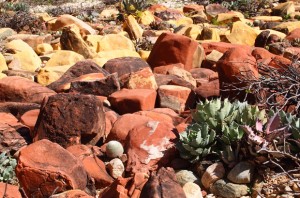
The originality of the garden is largely due to the input of a collection of artists Francesco Toledo, Alejandro de Ávila B and Luis Zárate. These three were instrumental in the design and implementation of the garden, and wanted the garden to reflect within the space the diversity of the local people who are known for their textiles, ceramics, cuisine, and complex use of plants. To this day, wild plants are used throughout the region for food, crafts, and medicine.
The garden educates the visitor of the area’s history by arranging plants both ecologically and culturally. There is a section for domesticated plants, and all the plants (with the exception of few species) are wild natives. The artists enlisted help from local gardeners and healers to help provide the many specimens for the garden. Large plants were brought in over time, but the people had limited experience of them so a period of trial and error has been honed over the years. When visiting, I was amazed that the garden had only been created over the last 20 years as it seems so settled and natural in its setting that it looks as if it has been there for far longer.
During the creation of the gardens many original features of monastery life were uncovered, dating back 400 years. A bathing washing pit is now shaded by soapberry, agave and other plants, which are used to make soap. Planted in the Library court yard is a fig tree, which was the species used to make the finest indigenous paper in pre -Columbian times.
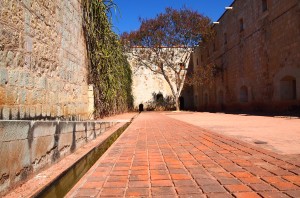
Many of the original water ways are still in use to capture the rain water and filter this to underground water tanks. The existing original features of the garden are enhanced by the new hardscape touches of iron borders, walkways over old iron kilns, black reflective pools showing the plants and architect in its reflection, bridges and handrails.
This garden is not like any other botanic garden. It is an artistic landscape of structural shapes set against the beautiful back drop of the monastery enhanced by expanses of Mexican sky. It educates and showcases the diversity of the Oaxaca region and its people. My visit was a truly pleasurable experience of seeing nature and creativity working together to make a truly unique public space. Inspiration a plenty for one of our next garden designs in Sussex.
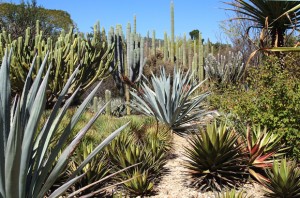
The idea of using native plants more and more in our designs works synonymously with a more environmental and low maintenance ethos to gardening. Why bring in plants when we have a plethora of interesting natives to work with which suit our climate and situation as well as being part of our history. Something to think about!
